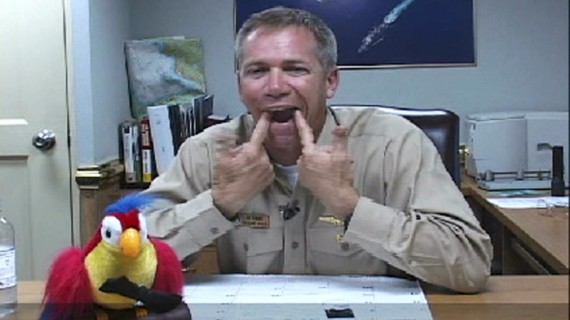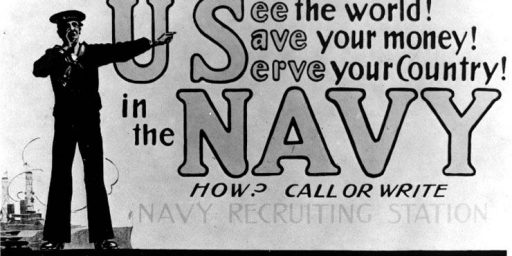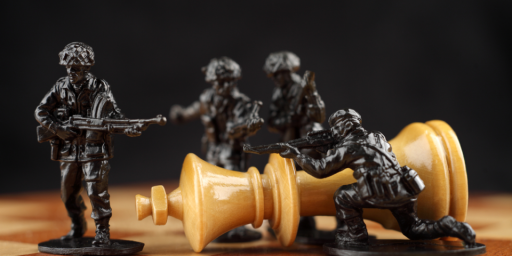Navy: Owen Honors Poor Leader, Should Stay in Navy
A Navy board of inquiry consisting of three admirals has voted to keep Captain Owen Honors, who was relieved as captain of the Enterprise, on active duty.
A Navy board of inquiry consisting of three admirals has voted to keep Captain Owen Honors, who was relieved as captain of the Enterprise, on active duty.
The three-admiral board unanimously agreed that Capt. Owen Honors committed misconduct, failed to demonstrate acceptable qualities of leadership required of an officer in his grade and failed to conform to prescribed standards of military deportment.
But it also voted 3-0 that Honors “be retained in the naval service.”
Because, apparently, the Navy needs more senior officers who’ve “committed misconduct, failed to demonstrate acceptable qualities of leadership required of an officer in his grade and failed to conform to prescribed standards of military deportment.”
Another Navy board will get a second chance, apparently:
How long he’ll be able to stay, however, may be up to an unrelated early retirement board. Charles Gittins, Honors’ attorney, said that while Honors has no official notification of consideration by the board, his time in grade and service fall into the range of officers being considered. Gittins said it’s his understanding that the results could be reported out as early as Sept. 1.
This morning, Raymond Pritchett, aka Galrahn, had a long, amusing rant explaining why Honors should be sent packing. Among the pithier selections:
In what American government professional occupation does an individual in leadership simulate masturbation in a training video that is broadcast directly to 5000 members of a government organization while simultaneously claiming the video is “acceptable conduct” or “standard performance”?
“United States Naval Officer, sir!” is apparently the correct answer.
via Sam LaGrone






I still don’t see what the BFD is. This was a humourous video that got a lot of good information out in a way that would have otherwise gone over the heads of a lot of Capt. Honors’ people. We’ve routinely been given the same information (while I was in), and it was like sitting through the economics class in Feris Bueller’s Day Off. This was a great video that kept things light on a LONG deployment for 95% of the ship.
As for the other five? Well, I don’t think women should be in a combat position or on a warbound carrier in the first place. More harm comes from them being out there than good, the least of which is they can’t do the bloody job in most cases, unless they’re on phone talking duty.
He was the XO, not the CO of Enterprise.
Big difference
But women are deployed aboard carriers and have been since 1979, before Honors joined the Navy. They’re flying fighter jets into harm’s way. They’re leading flight deck crews. They’re commanding Carrier Strike Groups. It’s time to adjust to that reality.
@Davebo: He was the CO at the time he was relieved. The videos were made while his was XO. I gather standard practice is to have the XO serve as the CO-in-waiting.
I flew off of carriers through the 70s and 80s, and served aboard the Enterprise on the Admiral’s staff for Desert Shield in 1990, and I never saw a female sailor as a part of ship’s company or the air wing. There might have been a female visitor in there somewhere. Where do you get your 1979 information, James? That doesn’t pass the smell test.
In fact, 1979 was the first year that women were deployed aboard US Navy ships, but only non-combatants. By the time I retired in 1994, I still had never seen a woman assigned to a combatant vessel.
@Christopher Bowen: Well, I don’t think women should be in a combat position or on a warbound carrier in the first place.
That’s nice, but neither you nor Capt Owens has the slightest thing to say about it. You’re (I assume) a civilian, and aren’t directly affected – Owens was a senior leader of a 5000+ person military organization, and damn well knew what his responsibilities were. He then chose to disregard those responsibilities. In short, a sailor’s opinion about the orders he’s given means exactly nothing. He carries them out or he finds a new line of work.
@James Joyner: Further research indicates that women were first deployed to aircraft carriers in 1994. It’s been a while, to be sure, but it hasn’t been since 1979, James.
But then again, only being off by 15 years is still pretty good for a former artillery officer. Ahem.
I served on the Washington from 2000 – 2004, and we had women in all aspects of the ship’s company, from phone talkers all the way down to at-sea fire parties. And outside of combat pilots, I know what women are doing, and what I’m saying is that they largely suck at it. Yes, the reality is that they’re out there, but the reality is also that they’re not very good at it, they often cause undue stress on teams either due to physical incompetence or due to pregnancies, and that they negatively affect ship’s morale.
I sound like a troglodyte when I say this, but this is the reality of serving in the so-called “New” Navy, and I’m sure the “New” Navy in 2011 is likely worse than the one I experienced ten years ago.
@Boyd: My own recollection matches yours–that integration of women into the combat Navy was something that happened in the Clinton administration. The Navy claims otherwise, however:
@James Joyner: Don’t assume these citations mean that women served on aircraft carriers, or combatant ships or aircraft, James. I flew with several women in the 80s, but that was aboard the EP-3E, certainly not a combat aircraft. And while women served aboard Navy ships, they were restricted to noncombatant vessels until much, much later than 1979.
From your same link:
Trust me when I tell you, James, that women weren’t serving in combat roles in the US Navy in 1979. I was there, then and for many years afterward.
There’s three ways to do anything: the right way, the wrong way, and the Navy way.
Keep digging James. Other than the occasional COD pilot I can assure you no women were aboard during my two cruises in the 80’s on either the Ike or the America.
Google has obviously let you down here.
Oh, and regarding LT Spruill: She landed a C-1 aboard the USS Independence in 1979. That’s what’s known as a COD (Carrier Onboard Delivery) in the Navy, a very small cargo aircraft delivering mail and other small, high priority logistical items. She wasn’t deployed aboard an aircraft carrier.
By Ms Spruill’s own account:
I know, you’re not as motivated to do this research as I am, James, but the point remains: 1979 as a watershed year for women aboard aircraft carriers is off by about a decade and a half.
And yes, all of this has very little to do with the original point of your post. But it’s what I do.
If an idiot like William C. Rogers III was allowed to stay in the Navy after he shot down a civilian airliner then this guy should be able to stay in as well.
Chistopher, we dealt with all this when women first entered the trades. None of us liked it. We had no choice.
Fact #1: Some of the trades, the avg women is more than capable of doing.
Fact #2: Some trades do not suit the avg woman.
Fact #3: Some women, due to their lack of “physical competence”, weren’t able to do the job in the trades not suited to them. They washed out
Fact #4: Some women, were more than capable to do any job any man could do.
Back in the late ’70s I lived in Wyoming. I remember a powder monkey who worked in the mines. 6-2, about 230. One night we were all hanging out at the Mint Bar (great place, if yer ever in Sheridan, check it out) and a war of words broke out. The bartender finally said, “Well if you can carry me out of here, I am your’s for the night.”
She did. And he was.
From what I can see, Capt Honors was not charged with a UCMJ violation. There is no reason to force him out of the service or into retirement if that is the case.
@Boyd: Gotcha. That’s what I get for trusting an official Navy source! As I noted before, my own recollection was that Clinton opened most of this stuff up to women, so I was surprised to see the 1979 date, too.
@DC Loser: I always thought getting relieved of command for a cause was a career ender. Maybe it’s an Army thing.
@James Joyner: “Ending a career” doesn’t necessarily mean getting kicked out, even in the Army, does it? Captain Honors’s career is certainly ended, at any rate.
FWIW, the official Navy source is accurate, but it was written in such a way that it’s easy to be misled by what’s presented. Which I don’t doubt was the intent of the author.
And so I leave you with the two cardinal rules of the Navy:
1) The Chief is always right.
2) If you think the Chief is wrong, refer to Rule #1.
National Geographic did a ten part series on the Nimitz (I think) as it left San Fran, went to Hong Kong, the gulf, Australia and back to San Fran. The focus was mostly on the crew. Male/female interactions was a HUGE problem. Basically, I kept thinking I was watching a bunch of high schoolers hooking up in the dark corners of a school. We put men and women together in tight spaces with high pressure jobs and periods of intense boredom, and then we wonder why there are problems???